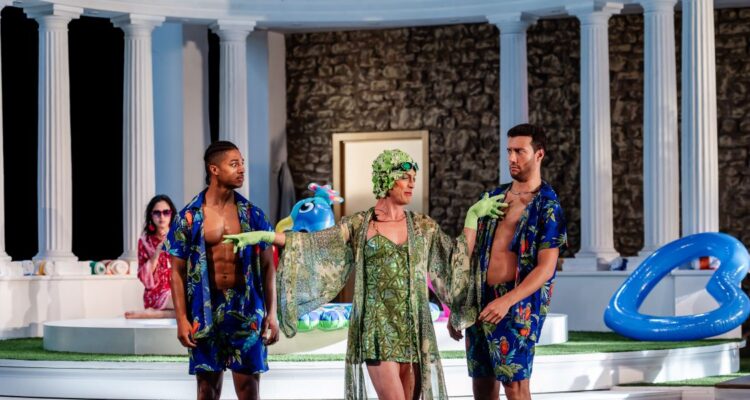While performances of operas by Handel and Vivaldi are now frequent, the same cannot be said of the French Baroque, which offers music and drama governed by a very different aesthetic, rarely showcased in this country. So it is all the more welcome that Rameau’s comic masterpiece ‘Platée’ (1745) receives a new and scintillating production at Garsington Opera. Concept is key in deciding how to approach highly stylised operas of this period; and director Louisa Muller takes a bold but brilliant decision in relocating the action from the literal pantheon of Olympus to the louche production studio of Olympus TV, where the preposterous pretensions of the Gods and the absence of rudimentary self-knowledge in the characters find a natural and precise parallel.
In both the original and this production Jupiter and Juno (whether gods or reality TV stars) have fallen out, and the minor gods (aka tv executives) have to devise a ruse to convince Juno to return to the show and reverse the ratings decline. After auditioning a whole series of starlets, they arrive at a wholly implausible new love-interest for Jupiter, whom Juno will immediately see as a joke. This is the water-nymph, Platée, muddy, clumsy and gauche, but convinced of her own invincible allure. She finds it wholly credible that Jupiter will fall for her, and much of the rest of the action follows through the cruel but funny consequences of her misapprehension, as the wedding preparations gather pace ahead of Juno’s ultimate return, and Platée’s inevitable rejection and return to her muddy pool.
The creative team have come up with a wonderfully garish set, costumes and props, though actually no more exaggerated than what regularly passes across our screens as reality entertainment. An upper level and video screen allows for the arrival and departure of the gods. A pool with classical colonnade is on one side and a day-glo interview set-up with bar on the other. Fuchsia flamingos and other inflatables come and go (wittily anticipated in a pedalo on the lake outside), and the centre stage is kept clear for the numerous dance episodes. Ripped torsos and fake tans abound; and no costume, whether skimpy or voluminous, could be described as modest.
The new scenario works especially well in redeeming the prologue, in this genre often a tiresome prelude preventing action, and turning it instead into a fascinating flurry of executive plotting and panic, ably assisted by the chorus as a wholly plausible hyperactive studio team. The conceptual energy also carries over inventively into the second half when plot developments flags a tad ahead of the denouement. The sequence of dances and diversions devised to accompany the intervention of ‘La Folie/Madness’ were wholly delightful, gathering regular bursts of well-deserved applause.
It should be said that the incorporation of so much self-conscious display and athleticism into the choreography is wholly in the spirit of Rameau’s original, where the dance ‘divertissements’ are integral rather than incidental to the opera, and not decorative. As each dazzling sequence of contrasted movements builds up to the next set-piece vocal number the cumulative virtuosity can be quite overwhelming. Here a lot of credit belongs to conductor Paul Agnew and the wonderfully precise ensemble of The English Concert in the pit. They are fully abreast of the quirky, rhythmically unexpected, alternately terse and tender, brilliantly pictorial textures of the music, with orchestral colours as surprisingly juxtaposed as the plantings at Great Dixter.
Rameau’s vocal style is very exacting, as much for the detail of characterisation and acting required as the technical demands, though they too are formidable. The boundaries of recitative and aria are blurred, and the interplay between the characters and the orchestral interventions is complex. At the centre of the action is Samuel Boden in the title role. He finds a wide palette of moods, and sings expertly despite being put through his physical paces. Moreover, by playing the role straight rather than for obvious laughs he is both funnier and more poignant. Henry Waddington and Robert Murray are wholly convincing as oily, scurrying executives, alternately ingratiating and bullying. Ossian Huskinson and Annabel Kennedy play up to the larger-than-life personas of Jupiter and Juno with panache, and Mireille Asselin rises to the major challenge of playing ‘La Folie’, who starts as a disc jockey and then morphs into coloratura display. Holly Teague registers too with an understated but eloquent little aria as Clarine. The superb local chorus perform splendidly whether as studio gophers, wedding guests or attendants on the gods.
This is a wholly delightful evening, evoking the spirit of the eighteenth-century ‘fête champêtre’ both in its idyllic setting and through the witty escapist parody of its scenario. Few tickets remain, but you will not be disappointed.
Composer: Jean-Philippe Rameau
Libretto: Adrien-Joseph le Valois d’Orville
Director: Luisa Muller
Conductor: Paul Agnew
Cast includes: Mireille Asselin, Samuel Boden, Ossian Huskinson, Annabel Kennedy, Robert Murray, Holly Teague, Henry Waddington
Photo Credit: Julian Guidera
Until 30 June 2024
4 hrs including dining interval

